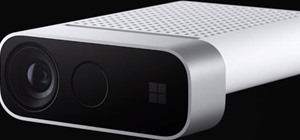
This time last year, we got our first taste of what mobile app developers could do in augmented reality with Apple's ARKit. Most people had never heard of Animojis. Google's AR platform was still Tango. Snapchat introduced its World Lens AR experiences. Most mobile AR experiences existing in the wild were marker-based offerings from the likes of Blippar and Zappar or generic Pokémon GO knock-offs.
In last year's NR50, published before the introduction of ARKit, only two of the top 10 professionals worked directly with mobile AR, and Apple CEO Tim Cook was ranked number 26, based primarily on his forward-looking statements about AR.
- Previous: NR30's People to Watch in Augmented Reality in 2018
- Next Up: NR30's Top AR Hardware Leaders to Watch in 2018
This year, Cook comes in at number one, with five others categorized under mobile AR in the overall top 10 of the NR30.
What a difference a year makes.
In just 12 months, we've seen mobile AR grow at a breakneck pace. Since Apple launched its AR toolkit, users have downloaded more than 13 million ARKit apps from the App Store, not including existing apps updated with ARKit capabilities. Apple has already updated its platform and will introduce even more new features to the public with the release of ARKit 2.0 this fall. Last year's iPhone X also introduced a depth-sensing camera and AR Animojis that captured the imaginations of its users.
Google retired the Tango project but followed Apple's lead by rolling out a platform with even more capabilities than ARKit 1.0 — ARCore.
Snapchat has expanded on its AR platform with developer tools and more advanced capabilities while extending the AR experiences to advertisement and e-commerce features. Facebook followed suit, duplicating Snapchat's AR features at every turn.
Even more advanced experiences are just around the corner, as AR cloud platforms promise not only shared and persistent experiences but also content that reacts to real-world objects even more realistically. (That's occlusion, baby.)
When asked what the most important achievement in AR was over the past year, the consensus of our NR30 honorees has been ARKit and ARCore. But for all its progress, mobile AR still feels very much like an early evolutionary step until small, wearable hardware dedicated to AR experiences enters the scene. In other words, while phone-based AR is at the top of mind now, AR that requires holding a phone in front of your face will be obsolete before we know it.
But for now, House Mobile reigns over the AR kingdom, and here are the lords that we owe allegiance to in 2018.
Tim Cook — Apple
Back in 2011, just months before Apple's co-founder Steve Jobs died, Tim Cook (pictured at the top of this article) assumed the role of CEO. In the process, he faced a nearly impossible task: following one of the greatest CEO runs in all of tech history that began with the Mac and soared to unprecedented heights with the iPhone. While the iPad struggled to find its footing in the marketplace, the company soon unveiled the Apple Watch, its first wearable computing device. At first, the skeptics dinged it, framing it as an experiment that might rank as Cook's first major misstep since the passing of the company's founder.
But, once again, the critics were wrong. Only this time, it was Cook guiding the public toward a brand new computing category (smartwatches) that other competitors had failed to popularize, despite being first to market. And now, in 2018, Cook stands at the precipice of a yet another computing revolution: augmented reality.
First introduced to the public in June of 2017 at the Worldwide Developers Conference in California, Apple's ARKit is now the most pervasive immersive computing platform, distributed to millions of users on iPhones and iPads around the world. And the TrueDepth camera on the iPhone X has quickly normalized the process of mapping and merging the real world with the virtual. And like the original Mac, the first iPhone, and the recently mainstreamed Apple Watch, there are still some AR skeptics who wonder why Apple is focusing on what appears to be such a niche category.
Nevertheless, we've now embedded the innovations of the iPhone X and ARKit in the fabric of our daily lives, and the rumors are already beginning to filter out: Apple may be preparing to release a pair of AR smartglasses. If true, it could be the perfect complement to its wrist accessory, and the final step toward putting Apple-everything in front of you at all times.
Of course, other AR hardware makers have shown us just how hard it is to make such a thing work well, much less small enough to fit within the frame of traditional glasses. But one thing is certain, after everything we've seen in the last few decades from the company, no one will be surprised when Apple unveils the coolest, most fashion-friendly pair of AR smartglasses we've ever seen.
In May, we learned that, despite its high price, the AR-friendly iPhone X became the world's best selling smartphone, boasting 345 million units sold as of Q1 2018. Apple still won't disclose the overall sales numbers for the Apple Watch, but most reports estimate that it remains on the top among all competitors. What happens when Apple marries the capabilities of the TrueDepth camera to with a well-designed wearable like the Apple Watch? Probably a hit in yet another, blue sky category. Cook isn't quite there, but all signs indicate that his team is working on it with laser focus.
In the meantime, ARKit is succeeding in giving developers a powerful platform that is consistently delivering mobile immersive computing experiences that astound. Sure, as of now, there are only a little more than 2,000 ARKit-powered apps on the App Store. But early iPhone developers still remember the days when creating an iPhone app was a crapshoot regarding return on investment. Today, developing an ARKit app that becomes a mainstream hit may seem like a long shot, but at the very least, developing for ARKit today will likely pay dividends when its time to create your Apple Glasses AR app.
And if the latest rumors are true, that day may be coming sooner than many had imagined. Stay tuned, Cook is in the process of pulling off a magic trick greater than any ever executed by Jobs, blurring the lines between reality and the virtual, anywhere you go.
Evan Spiegel — Snap Inc.
As co-founder and chief executive officer at Snap, Inc., Evan Spiegel is a pioneer in the mobile augmented reality space, and his company has created a platform that is now challenging the likes of Apple and Google in the space.

Spiegel and co-founder Bobby Murphy, both students at Stanford University when they met, launched Snapchat as an ephemeral messaging app in September 2011. Within a year, Spiegel left Stanford to run the business full-time. Now, Snapchat is a subsidiary of Snap, Inc., which went public in 2017.
It wasn't until 2015 that Snapchat began to dabble in augmented reality with Lenses, starting with front-facing camera effects using facial recognition. After acquiring Cimagine and its markerless augmented reality technology in 2016, Snapchat introduced World Lenses, which placed digital content, like the "world's first AR superstar," the dancing hot dog, in the user's environment. Today, the technology is one of the top three priorities of its 2018 business plan.
Ironically, Spiegel's app, which launched as the antithesis of Facebook, is now meeting the social media giant head-on as competitors in the social augmented reality space. That competition is sure to continue into the future with augmented reality wearables. While Snap's Spectacles don't have augmented reality capabilities as of yet, the company is reportedly working towards introducing a smartglasses version of the product in 2019, placing the company in the same arena as Facebook and its Oculus division, not to mention Apple's rumored smartglasses and Google's next attempt at the category.
Hugo Barra — Facebook
Looking at his resume, Hugo Barra technically has relatively little experience in augmented reality. However, it's his position as the vice president of VR for Facebook and his track record of developing hardware and software products that make him one of the more important faces in the industry going forward.

A native of Brazil, Barra earned his undergraduate and graduate degrees from the Massachusetts Institute of Technology (MIT), where he studied electrical engineering, computer science, and management science. He joined Google as a product manager in 2008, eventually ascending to vice president of Android Product Management by 2012. In 2013, he left Google to lead Xiaomi's international expansion efforts. Among his accomplishments at the Chinese smartphone maker was the expansion to India, which now represents $1 billion in revenue for the company.
After departing Xiaomi in 2017, Barra joined Facebook as the leader of all of Facebook's VR efforts. This includes Facebook's Oculus team, which also incubates the company's augmented reality technology. Facebook's roadmap for AR and VR has augmented reality integrating into Oculus VR within the next eight years — the Oculus team has already submitted a patent for its smartglasses.
"Hugo shares my belief that virtual and augmented reality will be the next major computing platform. They'll enable us to experience completely new things and be more creative than ever before," said Facebook founder and CEO Mark Zuckerberg in post welcoming Barra to the company. "Hugo is going to help build that future, and I'm looking forward to having him on our team."
Between his work at Google and Xiaomi, Barra has demonstrated the ability to grow product sales. As Facebook develops its augmented reality hardware via Oculus, Barra's leadership and market acumen will be instrumental to its success.
Clay Bavor — Google
All of the tech giants are working on some form of augmented reality, with Google among the first out of the gate with Google Glass back in 2013. Leading the company's latest AR efforts is Clay Bavor, vice president of augmented and virtual reality, who ascended to his position on wings of cardboard.

After earning his undergraduate degree in computer science from Princeton, Bavor joined Google in 2005. He cut his teeth working on several of Google's advertising products and then led the product and design teams for some Google's flagship apps and services, such as Gmail, Google Docs, Google Drive, and the Google Apps suite.
Later, Bavor co-created Google Cardboard as a DIY VR viewer in 2014. He continued to lead the product's development until he took the reigns of all of Google's AR and VR efforts in 2016. Those efforts included Tango, the augmented reality platform that harnessed depth sensors in smartphones and the software for running augmented reality experiences in Android apps.
Bavor's team shipped a pair of commercially available devices through Lenovo and Asus, but Tango never took off. However, Tango did serve as the foundation for Google's new ARCore platform that applies computer vision in place of depth sensors to anchor augmented reality content.
After introducing ARCore in August 2017 and officially launching the platform in February 2018, Bavor's team released the next iteration of the platform at Google I/O in May. The update brought Cloud Anchors, a multiplayer protocol that works on iOS and Android. ARCore is also enabling Google's web-based AR push through the webXR protocol.
So far, if everything continues as is, it's looking like Bavor's efforts at the search giant will likely have massive ripple effects on the rest of the AR industry.
Imran Khan — Snap Inc.
While Spiegel stands as the company's founder and CEO, Snap Inc.'s chief strategy officer, Imran Khan, set the course for the company's initial public offering in 2017 and quickly became the leader responsible for its advertising business. In other words, Khan was the executive who helped monetize augmented reality for Snapchat. But that successful track record is coming to an end, as Khan recently announced that he's stepping down from his position.

With a BA in finance and economics from the University of Denver, Khan enjoyed a long career on Wall Street before joining Snap, a move that turned heads in the business world. Previously, Khan served as managing director and head of global internet investment banking at Credit Suisse, where he advised on more than $45 billion in tech M&A and financing transactions and served as lead banker on Alibaba's IPO. Before Credit Suisse, Khan was a managing director and head of global internet research for JP Morgan Chase. In his time as an analyst, Khan authored reports on Google, Amazon, and Apple, and he has demonstrated expertise in the international tech business, mainly focused on China. (That experience will serve him well, as his next move after leaving Snap will reportedly involve starting his own investment firm.)
Driving the revenue engine for Snap, Khan has continually expanded and introduced new platforms for advertisers to leverage augmented reality in their campaigns. In 2017, Snapchat opened up Lenses and World Lenses to sponsorship opportunities. And in 2018, Snapchat further expanded its AR advertising lineup to include its new Snappables AR gaming platform, which also offers brands e-commerce tools by way of its Shoppable AR platform.
To say that Snap will miss Khan's presence would be a huge understatement. But Spiegel has become adept at forcing the company to reinvent itself, so the gap within the top ranks of Snap's executive team probably won't last very long.
John Hanke — Niantic Labs
John Hanke, as founder and CEO of Niantic Labs, and with an assist from Google, can be credited with pioneering location-based augmented reality gaming with Ingress and then popularizing it with Pokémon GO, as an independent company. Through Pokémon GO, Hanke and his company have also introduced augmented reality to the mainstream.

If you go way back, the roots of Niantic start with the geospatial app company Keyhole, which Hanke founded in 2001 and Google acquired for $35 million in 2004. Hanke continued to lead the Keyhole team as they developed Google Maps, Google Earth, and Street View.
In 2010, Hanke started Niantic Labs as a Google subsidiary. Niantic published its first app in 2012 as Field Trip, an app that uncovered landmarks and points of interest based on the user's location that has served as the backbone for its location-based gaming. Later in 2012, Niantic published its first game, Ingress, a cyberpunk-influenced, world-spanning version of Capture the Flag that turned landmarks into portals, divided players into rival factions, and achieved a cult following.
In 2015, the company was spun off as an independent entity with a $35 million Series A round of funding from The Pokémon Company Group, Google, and Nintendo, and subsequently announced Pokémon GO, which launched the following year. The game not only built on the foundation of Ingress with franchise-influenced elements, but it also gave players the opportunity to see the classic pocket monsters in their physical environment. While the game's zeitgeist-capturing popularity has waned somewhat in recent months, it's still among the top-grossing mobile apps.
Today, Niantic Labs, valued at $2 billion, is expanding its portfolio of location-based games with the forthcoming Ingress Prime reboot and Harry Potter: Wizards Unite games. The company is also promising to introduce the next generation of mobile augmented reality with its Niantic Real World Platform, which enables developers to create persistent content that reacts to the real world and build shared multiplayer experiences.
Born and raised in Texas, Hanke graduated from the University of Texas in 1989 before earning his MBA at the University of California in 1996. Back in the '80s, it was probably difficult for most of us to imagine the kind of games and apps Niantic is currently creating. But it's that kind of pioneering spirit and vision, fostered long ago, that has helped Hanke stay on the cutting edge, even as that edge fades away into virtual objects on the frontier of augmented reality.
Adario Strange and Tommy Palladino both contributed to this article.
Just updated your iPhone? You'll find new features for Podcasts, News, Books, and TV, as well as important security improvements and fresh wallpapers. Find out what's new and changed on your iPhone with the iOS 17.5 update.























Be the First to Comment
Share Your Thoughts